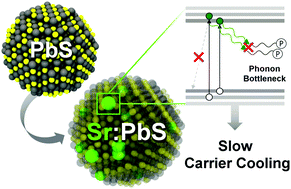Slow excitonic carrier cooling in Sr-doped PbS nanocrystals for hot carrier devices: an integrated experimental and first-principles approach†
Abstract
Minimizing the carrier–phonon interactions in polar semiconductors is of great importance for designing hot carrier optoelectronic devices, as it is directly related to the excitonic energy dissipation. Phonon modifications, together with the hot phonon bottleneck effect in nanocrystals, are known to effectively reduce the carrier–phonon interactions. With this aim, we report the excellent sensitizing properties of strontium doped lead sulphide (Sr:PbS) nanoparticles for optoelectronics applications. The transition states involved in the multiple exciton generation (MEG) are probed by the derivatives of the absorbance spectra. The high carrier concentration in Sr:PbS leads to the bottleneck effect, which is confirmed by the Burstein–Moss shift and I–V characterization. Furthermore, the excitonic carrier–phonon interactions are studied by examining the strength of their coupling effect via Huang–Rhys factor. Compared to the coupling strength of pure PbS, that of Sr:PbS is notably decreased and this consequently suppresses energy dissipation occurring through carrier–phonon interactions. The first-principles calculations confirm that the Sr dopant locally creates a phononic bandgap that inhibits the energy dissipation by decreasing Klemens decay. The results throughout the study demonstrate effective and facile means to decrease the excitonic energy loss in active materials for hot carrier optoelectronic devices.



 Please wait while we load your content...
Please wait while we load your content...